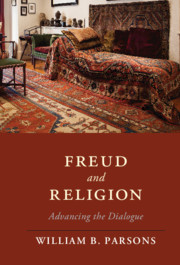Book contents
- Freud and Religion
- Cambridge Studies in Religion, Philosophy, and Society
- Freud and Religion
- Copyright page
- Contents
- Introduction
- 1 Why Freud Wrote on Religion
- 2 Totem and Taboo
- 3 Freud’s Moses
- 4 Future of an Illusion
- 5 Civilization and Its Discontents
- 6 Freud and Eastern Religions
- 7 Psychoanalysis and Religion beyond Freud
- 8 Revisions and Applications
- Conclusion
- Bibliography
- Index
7 - Psychoanalysis and Religion beyond Freud
Published online by Cambridge University Press: 07 May 2021
- Freud and Religion
- Cambridge Studies in Religion, Philosophy, and Society
- Freud and Religion
- Copyright page
- Contents
- Introduction
- 1 Why Freud Wrote on Religion
- 2 Totem and Taboo
- 3 Freud’s Moses
- 4 Future of an Illusion
- 5 Civilization and Its Discontents
- 6 Freud and Eastern Religions
- 7 Psychoanalysis and Religion beyond Freud
- 8 Revisions and Applications
- Conclusion
- Bibliography
- Index
Summary
It was primarily after World War II, in the second (1945–1969) and third (1970 to present) periods of the psychology and religion movement, that classic Freudian psychoanalysis, having achieved the founder’s wish of international dissemination, being informed by a new clinical base from diverse cultures, alternate complexes not named Oedipus, and a generational turnover of theorists, began to evince the creation of new clinical techniques and formulations. During this time, there emerged dozens of diverse figures who not only have come to dominate the contemporary “what” of psychoanalysis but have done so in ways that creatively assimilate the best of Freud while repudiating some of his less-compelling formulations. It is safe to say that Freud himself would have been uncomfortable with at least some of these innovations, particularly those that valorize an appreciative view of religion. At the same time, Freud was willing to admit that his efforts at applied psychoanalysis reflected his own proclivities; that his various analyses of religion were his “personal views, which coincide with those of many non-analysts and pre-analysts, but there are certainly many excellent analysts who do not share them”; and that his preferences “need deter no-one from using the non-partisan method of analysis for arguing the opposite view.” Indeed, many of his heirs took him up on that offer.
- Type
- Chapter
- Information
- Freud and ReligionAdvancing the Dialogue, pp. 188 - 220Publisher: Cambridge University PressPrint publication year: 2021



